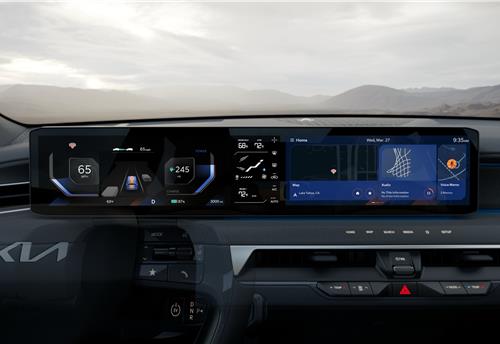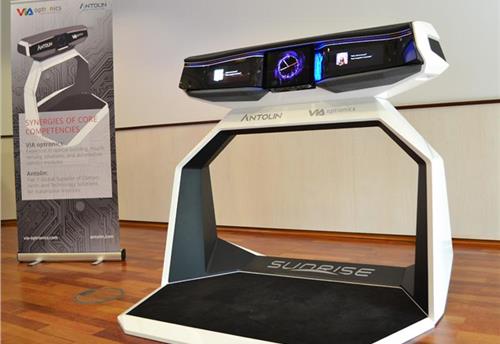Jaguar Land Rover looks to enter SUV-coupé market
The Tata Motors-owned luxury carmaker plans first ever road-biased model with a Range Rover Sport Coupé which will target the BMW X6.
Range Rover’s next new model will break fresh ground by moving the brand into sportier and more-road biased territory with a £60,000 (Rs 59 lakh) luxury model pitched at the BMW X6.
The new model, codenamed L560, could be named Range Rover Sport Coupé. It has been known for some time that a Range Rover was being developed that shared its alloy chassis with the Jaguar F-Pace, but the make-up of the model has been kept secret.
Three years ago, when Autocar UK revealed Land Rover’s ‘three-pillar’ brand strategy — Defender, Discovery, and Range Rover — the Sport Coupé was referred to as ‘Evoque XL’ and positioned between the Evoque and Range Rover Sport.
Launch expected next year
Today, insiders continue to refer to it as Evoque Plus while publicly denying that any such production model exists.
Many details of the new Sport Coupé remain secret in the build-up to its launch, which is expected next year.
However, Autocar UK has pieced together a picture of a new model that will set new standards for a Range Rover’s styling, interior and road-focused handling, the last of these coming courtesy of the F-Pace’s suspension and lightweight aluminium body. Range Rover’s first battery electric vehicle may also be spun off the new model.
Land Rover design chief Gerry McGovern and Range Rover design boss Phil Simmons are understood to be developing a new look for the Sport Coupé to exploit the sporty, long-bonnet proportions of the F-Pace.
At around 4.7 metres long, the new Range Rover will also be a little smaller than the 4.9-metre X6 and GLE Coupé and will fit between the 4.4-metre Evoque and 4.85-metre Range Rover Sport.
Those dimensions also put it close to the 4.6-metre BMW X4, but the price positioning is expected to be much nearer to the bigger German rivals.
Luxurious interior
McGovern has previously alluded to a new Range Rover that will be a bigger surprise than the Evoque.
The cabin, for example, is expected to be more intimate than those of current Range Rovers and, in an echo of the layout of the BMW X6 and Mercedes-Benz GLE, is being designed around a luxurious four-seat layout. A 2+1 rear seat with fifth seatbelt will be on the options list.
Autocar UK has been told by insiders that the F-Pace’s alloy architecture is not capable of stretching to a three-row, 5+2 seating arrangement — the configuration previously attributed to the ‘Evoque XL’.
The cabin will be more like a ‘cockpit’ than any previous Range Rover and feature a dramatic sloping roofline and tight rear overhang.
The rear doors will be reduced to minimal openings in the search for the most elegant styling possible, while the luxury-quality interior is understood to introduce new materials and finishes.
The target market will include an ‘urban cool’ group of buyers and the palette will be chosen with them in mind.
All-electric powertrain possible
Powertrains will be drawn from the extensive Jaguar Land Rover range of six and eight-cylinder diesel and petrol engines, but it is not yet clear if the new Range Rover will feature the four-cylinder engines that are available in the Jaguar F-Pace.
It could also feature the all-electric powertrain that JLR is developing for its I-Pace EV, which should be seen next year and will help JLR hit a new Californian target of 15% fleet mix of battery electric vehicles between 2018 and 2025.
Also read: Electric powertrains will "reinvent the car" says Jaguar design chief
However, because many buyers will live in mega-cities in Europe, the United States and Asia, Range Rover is expected to offer a hybrid powertrain, possibly based on the 340bhp 3.0 SDV6 HEV in the Range Rover Sport.
If Range Rover chooses to fit its most powerful 542bhp 5.0-litre V8 supercharged engine, the new model will offer outstanding performance, partly because its lightweight alloy body could weigh as little as 1800kg — a 400kg advantage over the X6 and GLE Coupé.
That engine is thought to be earmarked for an F-Pace SVR model and for the range-topping model of the Sport Coupé range, which could command a price of around £90,000 /Rs 88.58 lakh (in the UK).
Another crucial decision to be made is the name of the new car. In many ways the new Range Rover would be more deserving of the ‘Sport’ name than the current sevenseat model that wears the badge. Range Rover won’t discuss this key detail, except to confirm that the existing Sport will keep its name.
Land Rover’s growing global footprint
Land Rover builds and sells 400,000 cars a year, and while many are made in the UK, the company is rapidly expanding its overseas production.
The UK still builds the majority — Halewood the ‘D8’ steel-platform Evoque/Discovery Sport and Solihull the alloy-bodied ‘D7u’ Range Rover/Range Rover Sport and steel-bodied ‘T5’ platform Discovery.
Solihull will shortly close down the T5 line and switch production of the new alloybodied Discovery to the ‘D7u’ line where the Range Rover and Range Rover Sport are built.
It is very likely that the Sport Coupé will be made at Solihull too, on the plant’s second line, which currently assembles the Jaguar XE, XF and F-Pace.
However, the UK’s grip on Land Rover production is reducing rapidly, with three new overseas plants adding more than 300,000 units of capacity as part of owner Tata Motors’ latest £4 billion (Rs 39,372 crore) investment in new plant and models.
In China, a £1 billion (Rs 9,843 crore) joint venture plant with Chery has been building the Evoque and Discovery Sport since October 2014. It can build 130,000 units a year, although faltering sales in the Chinese new car market may yet slow this down.
Smaller scale, but just as strategically significant, is the new £240 million (Rs 2,362 crore) plant in Brazil that’s due to start making its first cars this summer. Its capacity is 20,000 units a year of the Evoque and the Discovery Sport.
Of more significance is the new £1 billion (Rs 9,843 crore) greenfield plant in Nitra, Slovakia. It is scheduled to have an eventual workforce of 2800 that will build 150,000 cars a year from 2018.
The Slovakian facility will be a high-tech plant capable of building aluminium-bodied cars. It will ease the pressure on Solihull, which is running flat out.
There’s no word yet on which models will be built in Slovakia, although the opening date in 2018 is close to the launch date of the new Defender.
RELATED ARTICLES
Marelli Talbros Chassis Systems wins Rs 1,000 crore business from European OEM
The order, to be executed over an eight-year period, is for the supply suspension arms tailored for both conventional in...
Kia launches customised NBA display themes for North American market
Display Themes is a customised service that supports a personalised vehicle experience, allowing users to customise the ...
Antolin and VIA Optronics unveil versatile vehicle cockpit concept
The Sunrise vehicle concept cockpit, which is engineered for seamless transitions between manual and autonomous driving ...





 26 Mar 2016
26 Mar 2016
 8254 Views
8254 Views





 Autocar Pro News Desk
Autocar Pro News Desk




